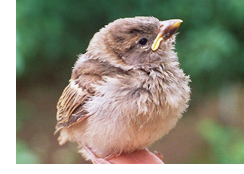
Healthy baby birds have a much greater chance of survival if left in their natural environment with their parents. This is because their parents teach them how to fly, what to eat, how to find food and how to avoid predators. It is important to know when and how to rescue a baby bird that is in trouble as this can severely affect their little lives.
There are two different types of chicks – Precocial and Altricial
PRECOCIAL CHICKS
These are: ducks, masked lapwings (plovers), swamphens, moorhens and brush turkeys
Precocial chicks are born covered with down, with eyes open and are able to walk soon after the hatch. They need the watchful eye of their parents until they are independent but are able to feed themselves.
WHAT TO DO IF YOUR FIND ONE
Help a separated precocial chick by placing it safely under cover such as a dense bush or shrub. Do not feed or water. Keep a watchful eye from a safe distance so that the parents feel comfortable to return to their chick.
WHEN YOU SHOULD INTERVENE
- A precocial chick will need help if
- They have little or no feathers and can’t be returned to the nest.
- They are injured or have been mouthed by a cat/dog
- They are cold and/or lethargic
- Their parents are deceased
- Their parents do not return
HOW TO HANDLE A PRECOCIAL CHICK
Place the chick into a small, ventilated box with a soft towel on the bottom and keep in a warm, dark and quiet place. DO NOT feed or water as they have specialised diets. Contact your local wildlife care group for more information.
Please note, parrots, lorikeets, kookaburras, kingfishers and other birds that nest in trees require more specialised nesting environments and need to be referred to your local wildlife group immediately.
ALTRICIAL CHICKS
These are: honeyeaters, magpies, butcherbirds, magpie larks, kingfishers, parrots, pigeons, doves and raptors
Altricial chicks are born with closed eyes with little to no feathering for warmth. They are completely dependant on their parents until they are old enough to leave the nest.
Featherless altricial chicks have little/no feathering and need to be kept warm. Providing a hot water bottle wrapped in a towel is best before taking the chick to your local wildlife hospital or carer ASAP. DO NOT feed or water.
Fledgling altricial chicks have most of their feathers and are just starting to reach adulthood. If you find one of these fledgling chicks do not be overly concerned as they are probably just learning to fly and their parents are nearby. If concerned, place the chick on a branch or nearby bush/shrub for safety until they return. DO NOT feed.
BUILDING AN NEST FOR AN ALTRICIAL CHICK
If you find an altricial chick it probably means they have tried to fly to early or have been blown around by some wind. Help is as easy as making an artificial nest and helping them won’t mean they’ll be rejected by their parents.
This artificial nest is great for open nesters such as magpies, crows, noisy miners, magpie larks, butcherbirds and tawny frogmouths.
- Punch several holes in the bottom of a bucket, ice cream container or hanging basket to provide drainage.
- Place a layer of leaves or grass in the bottom. Also place a stick in the bucket at an angle by securing it into one of the holes. This will allow parents and baby to get in and out easily.
- Place the baby in its new home and hang the bucket at head height ina leafy tree or bush away from direct sunlight and predators. Make sure the bucket is as close as possible to the spot you found the chick.
- Watch from a distance to make sure the parents return to feed the baby. If the parents do not return by dark the baby will need to come into care.
PLEASE NOTE: Under the Queensland Nature Conservation Act 1992, it is illegal to keep protected wildlife without an appropriate permit. Wildlife carers have been trained to provide the best possible care for our native birds and have the equipment and specialised foods that they require.

